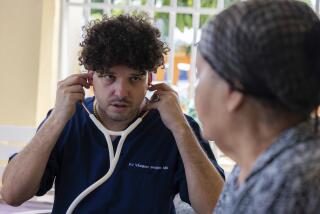‘Sams’ Fly Missions of Mercy : Medicine: Oxnard doctor Dale Hoyt flies to Baja every month to treat the sick--28 years after he founded the 1,400-member Flying Samaritans.
PUNTA PRIETA, Mexico — The ruddy-cheeked man in the brown leather bomber jacket clambered out of the Cessna 210 and looked briefly across the forsaken plain, the dusty view broken only by occasional clumps of cactus and scrubby underbrush.
Eager to check on a baby he had helped treat for a brain abnormality, Dr. Dale Hoyt waited for three gun-toting soldiers in camouflage to finish inspecting the plane. Then he hurried across the small military landing strip and hoisted himself onto the back of a rusty, orange cattle truck heading toward the 100-person village of Punta Prieta.
But bad news waited there for the 68-year-old Oxnard doctor who founded the Flying Samaritans, an organization that has provided medical services in remote areas of Baja for 28 years.
The 15-month-old baby had been dead for a week.
“It’s hard,” Hoyt said, shaking his head slowly back and forth. “It’s really hard.”
Kay Hoyt, 55, the doctor’s wife and assistant for 14 years, struggled against her tears as did some of the other 20-odd volunteers who had traveled for three hours in private planes to host their monthly medical clinic.
But the doctors, nurses, dentists, pilots and errand-runners had little time for grief.
It was 1 p.m. and in just a few hours the sun would dip behind the mountains, making it impossible for the five private planes transporting the group to fly to the next town, Bahia de Los Angeles, where there are no lights to illuminate the small landing strip.
The team members--some along for the first time, others seasoned veterans of the expeditions--hurried into a light-blue building that had been set up for medical services.
The outside walls were punctuated by jagged holes. Inside, particle-board partitions smudged with dirt and buckling from their frames separated three examining rooms and a dental office, where two antique chairs faced each other.
In the pharmacy area, seemingly endless bottles of pills and creams, most donated by doctors from the United States, crammed makeshift plywood shelves. A cardboard box served as a trash basket.
Outside, townspeople gathered around. The arrival of the Flying “Sams” is about the biggest social event in town, drawing people from outlying communities who are eager to see the doctor or the dentist.
The clinic is the only means of medical treatment for many of the people in and near Punta Prieta, a town about 500 miles south of Ventura County that was built as a compound for road workers during construction 15 years ago of the two-lane highway that extends the length of Baja’s finger-like peninsula.
People still live in the barracks-like structures that include a communal eating hall and recreation room. The outlying area is dotted with houses, built mostly of cinder blocks, interspersed with abandoned cars rusted to their chassis.
To this and other poor communities, the Samaritans provide a scholarship program to encourage children to stay in school. On this trip, they also hosted a Christmas party, for which kids lined up to choose from hundreds of toys.
Meanwhile, a steady stream of people swarmed around the entrance of the medical clinic, where Flying Sams sorted records at a card table.
Hoyt waited in an examination room along with his wife and a nurse.
As he mused about his observations--”Little bit of redness in left ear canal . . . OK, they’re both red”--Kay Hoyt took copious notes.
She read them back to him, whereupon he made a diagnosis and called out an appropriate prescription.
To most of the people he sees, Hoyt is just another doctor with the group.
Even new Flying Samaritan volunteers ask chatty questions about his background, not realizing he is responsible for the international organization that boasts about 1,400 members.
The idea for the organization took form in 1961 after two American pilots flying from La Paz to San Diego were forced to make an emergency landing on an isolated mesa during a dust storm. People from the nearby village of El Rosario fed and sheltered the two women before finding more fuel for their plane and sending them home.
Impressed with the kindness of the townspeople, the two women, Polly Ross and Ailene Mellott, organized an airlift of food and toys to the 1,200 people in the fishing village. Hoyt, a pilot with the Civil Air Patrol, joined the effort. After the deliveries had been made, the villagers were asked if they wanted to see a doctor.
On that first visit, Hoyt held office hours on a kitchen table as another pilot held a flashlight for him to see. He examined only 22 people--some with hernias or tonsillitis, one woman with cancer of the uterus--before he ran out of supplies.
Drawn again and again by the needs of the people, Hoyt continued flying back to the remote town.
“I was frustrated,” Hoyt said. “Walking off and leaving somebody was kind of rough.”
Within months he had established a monthly clinic that ultimately became the Flying Samaritans, a nonprofit organization with nine chapters in California and others in Arizona and Tijuana.
The largest chapter is called the Foothill Chapter and has about 300 members from around Los Angeles and Ventura counties. Hoyt joined this chapter when he moved to Oxnard from Orange County two years ago to begin a personal injury practice.
The Hoyts were attracted to Oxnard because it is far enough from Los Angeles to be rural but close enough for access to different cultural activities.
“Oxnard is a comfortable town, a caring town,” Kay Hoyt said.
While he was very active in the Flying Sams in the past, Hoyt has begun to slow down in recent years, content to fade into the background and leave the leadership of the group to others.
On his trips to Mexico, he concentrates only on treating those who come to see him, his ego seemingly uninflated by the kudos given to the welfare service that helps people in more than 20 Mexican towns.
“It is of great significance to our lives,” said Margarita Cota, 42, Punta Prieta’s unofficial mayor. “They have done a great many helpful things.”
If a medical emergency arises between the periodic visits from Hoyt and his colleagues, residents try to borrow a car and head to Ensenada or Tijuana.
Otherwise, they wait for the Flying Samaritans.
Maria Sanchez, 38, wanted to see the dentist about a sore tooth that has hurt her for more than a year.
“I can eat nothing too cold and nothing too hot,” Sanchez said. “I am not able to eat on the left side of my mouth.”
Indolecio de Perez, 72, and his wife, Germana, 60, walked for four days to get to the clinic. The old man, wearing a soiled blue dress shirt and black shoes scuffed to a dull gray, was told he must have surgery for a hernia. His sight also is failing.
“We used to make saddles,” Germana de Perez explained. “Now, he cannot see. He is not able to cut the leather.”
In halting Spanish, a nurse explained that Germana de Perez must also seek further tests and treatment at a Baja medical clinic for an abdominal infection caused by unsanitary drinking water.
But the Samaritans could do nothing more for the couple that day. They had treated about 40 people, and it was time to board their planes and head to Bahia de Los Angeles, a coastal fishing village of about 500 people.
Dale and Kay Hoyt stayed near the back of the cattle truck. She exchanged pleasantries while Hoyt, a quiet man with a wry sense of humor, studied the others on the trip.
Hoyt, with his calm blue eyes and slate-gray hair, spoke in a slow and measured manner as he recalled his first visits to Mexico. When Hoyt began the clinics, he would bring his family, putting them to work. His brother interpreted for him. His wife held a flashlight during surgery.
The villagers were not used to the ways of the Americans, Hoyt said.
Nurses on the trip were warned by the local residents that wearing shorts was improper. The modest townspeople were reluctant to submit to exams.
“There were so many gowns and slips that to do a pelvic exam in those days it was difficult to get all those clothes off,” Hoyt said.
They spent one night in a room with goats, Hoyt recalled. They also slept in sleeping bags under the wings of their plane.
As he reminisced, it became apparent how much the organization has meant to Hoyt. For Kay Hoyt, also, the group is as important as family.
“We eat together and work together for 24 hours and we are four to six little people up in a plane all together,” Kay Hoyt said. “You go down with strangers, and you leave hugging.”
Hoyt disengaged himself from the Samaritans for five years, when he and Kay moved to Northern California where they started a farm raising exotic animals and he lived the life of a country doctor.
A nostalgic trip back to El Rosario in 1984 illustrated to Hoyt how much he missed his work in Mexico.
As Hoyt walked through the town where he had held the Samaritans’ first clinics, people came down from the hills to welcome him, Kay Hoyt said.
“They would say, ‘Don’t you remember you delivered my baby?’ ” Kay Hoyt said. “ ‘He’s 21 now.’ ”
He rejoined the Flying Samaritans, treating everything from leprosy to cleft palate. He has amputated a gangrenous foot and removed part of a cancerous ear. He has seen a woman, her cancer metastasized, seemingly cure herself with doses of an Indian tea made from local plants. And he has arranged surgery in the United States that allowed a girl to regain her sight.
Now, though, the Hoyts and other Flying Samaritans are turning their attention to the future.
Dale and Kay Hoyt are anticipating their next trip.
“It’s been fun as well as a challenge,” Hoyt said.
More to Read
Sign up for Essential California
The most important California stories and recommendations in your inbox every morning.
You may occasionally receive promotional content from the Los Angeles Times.









